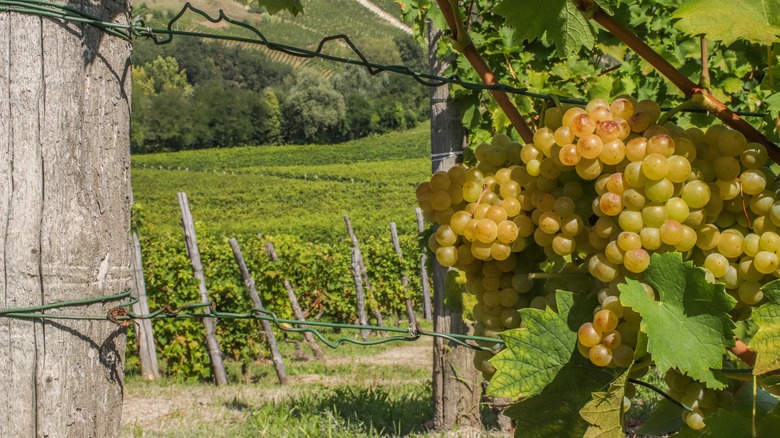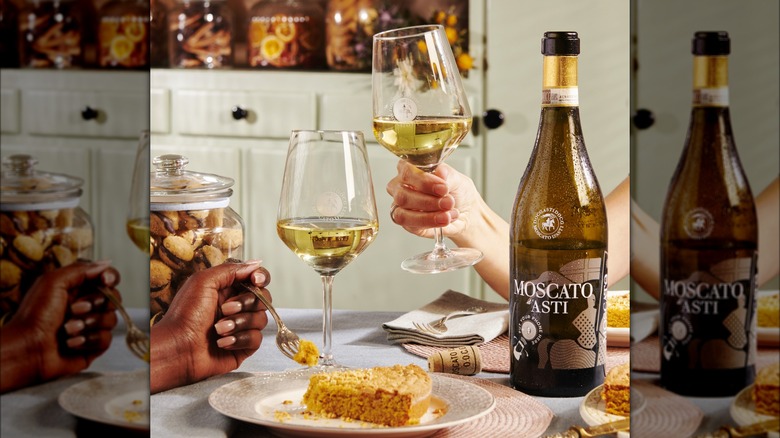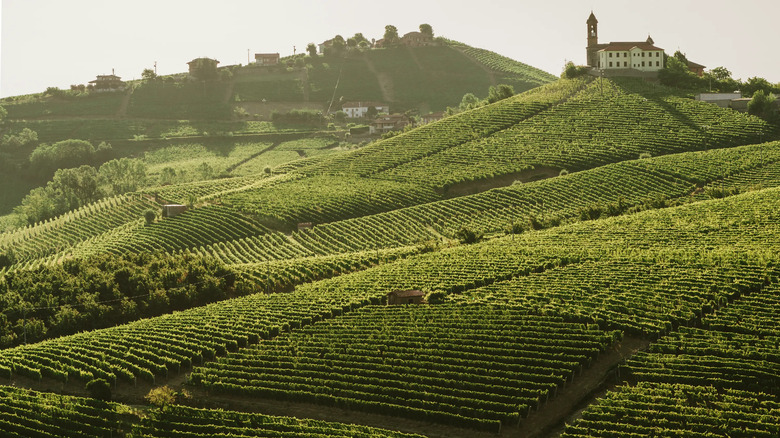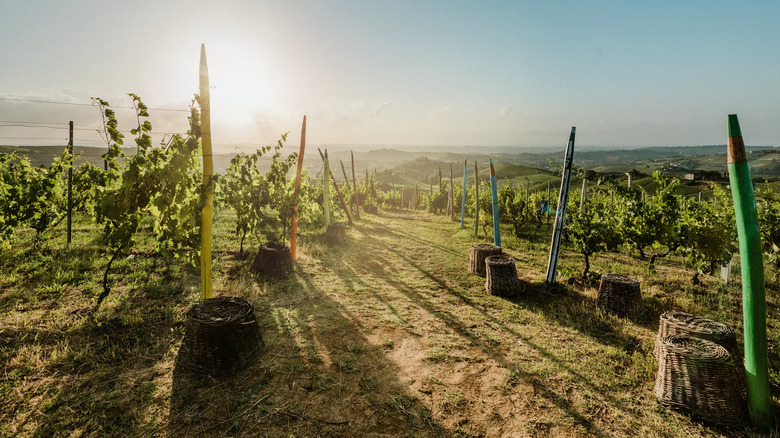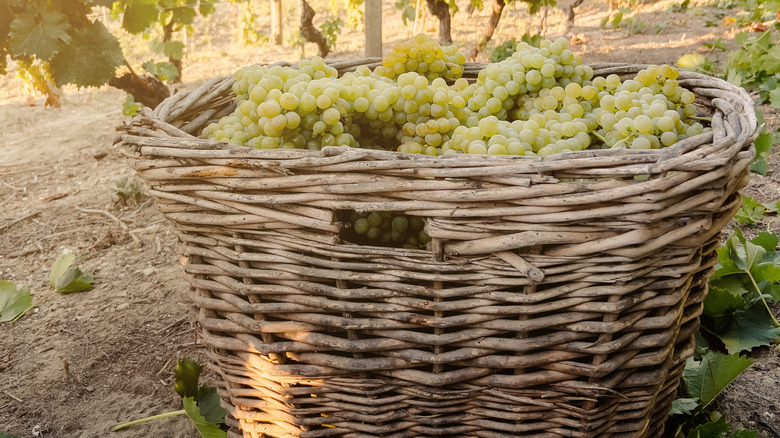What's The Difference Between Moscato d'Asti And Other Moscato Wines?
The world of wine is rife with confusion, thanks to millennia of history spanning the globe. You'll find the same grape identified with numerous labels and areas that highlight incredibly specific qualities absent anywhere else. Unless you're doing a deep dive on the matter, the answers aren't sitting in plain sight. Part of the confusion comes from the terminology; it's common to find wine bottles labeled by region, by grape, and in some cases with both. For example, you might eye a bottle of moscato and Moscato d'Asti side by side on the shelf at your local liquor store and wonder how they're connected.
The former is thought to be one of the most ancient wine grapes, popular with the Romans and Greeks. Also known as muscat, there are several varieties in the same family, most notably muscat blanc à petits grains, aka moscato bianco. On the other hand, Moscato d'Asti is moscato bianco from a prized Italian region that boasts the highest level of quality control. Whereas the grape variety and its relatives are grown around the world, Moscato d'Asti comes from Asti, in the Piedmont region of Italy.
Both offer a tantalizing flavor profile and countless opportunities for imbibing, and it's worth getting them straight. Learn the ins and outs of what distinguishes these aromatic wines, so you can hone in on what you love.
What is the moscato grape?
Muscat counts a couple of hundred varieties in its family including muscat blanc à petits grains, muscat of Alexandria, and muscat Ottonel, among others. Although many wine grapes take on a palate of fruit flavors, these grapes tend to smell and taste like grapes. As well, the different muscat varieties are also notably fragrant. Floral, perfumed, and honeyed aromas mingle on the palate with fruity notes like apricots, mandarins, and peaches.
Muscat blanc à petits grains is commonly viewed as the finer of the lot and has been traced back to ancient Greece. The grapes are small orbs showcasing a range of hues from golden to pink to brown. The resulting wines span the sweetness spectrum as well, making top-quality dessert wines as well as sparkling and dry table wines, ranging in alcohol content.
Per its name, muscat of Alexandria likely originated from Egypt and sports rounder fruit with a less refined taste. It's mostly used in sweet and fortified wines, often blended with other varieties. Muscat Ottonel has a far shorter history and its less notable aromatic character makes it less interesting to oenophiles. This variety is also a cross of two grapes designed by a French cultivator in the mid-1800s. Unlike other muscat vines, it does well in cooler climates which is reflected in its growing regions.
What is Moscato d'Asti?
Although Moscato d'Asti wines are produced with the moscato bianco grape, the regulations surrounding its territory, growing conditions, and viticultural practices make it unique. For starters, it holds the top standard of quality for Italian wine, known as DOCG, or Denomination of Controlled and Guaranteed Origin. This means the only product that can be identified with this label must be made within a restricted area in Asti, Piedmont, in Northwestern Italy. The climatic conditions and terrain of the region are optimal for the grape's striking features, bringing out its floral nature, aromatic character, and subtle muskiness.
Moscato d'Asti is lightly sparkling with a low alcohol content limited between 4.5% and 6.5%, making it an excellent aperitif or after-dinner drink. In contrast, standard table wines typically sit around 11% to 13% alcohol by volume. Most notably, Moscato d'Asti has a high sugar content, which adds to its appeal as a dessert wine. While it's an excellent pairing with fruit tarts, creamy desserts, and sponge cakes, the wine makes a remarkable match for spicy Thai or Indian dishes, as well as seafood, poultry, and glazed ham.
Moscato d'Asti comes from a restricted region
As noted in its name, Moscato d'Asti comes from the Asti region of Piedmont in Italy. The region is so well suited for moscato bianco vineyards (9,700 hectares of them to be exact) that it is recognized by UNESCO as a world heritage site. Within this demarcated area, just over 50 communes are permitted to produce the wine, resulting in a wide diversity thanks to unique types of soil composition, altitudes, relative proximity to the sea, and the resulting micro-climates.
Additionally, the orientation to the sun and the effect of morning fog can create vast distinctions between the many sub-regions. Depending on whether vineyards are located in the dips or on steep hillsides, the fruit varies in concentration and aromatics. That said, the grapes are all picked for optimal ripeness, when there is the perfect equilibrium between the notable sweetness and an element of acidity. This ensures the flavor profile fits within the predetermined characteristics for Moscato d'Asti wines.
The moscato grape is grown all over the world
The moscato grape family covers vineyard areas around the world, which is understandable considering its vast history spanning the ancient Greeks, Romans, and Egyptians. Still, there's a clear preference for European climates, as the majority of moscato bianco and muscat of Alexandria vines worldwide are in Italy, with lesser amounts in France, Spain, Portugal, and South Africa. Australia holds a decent chunk of muscat vines too, which produce the country's famed fortified dessert wines from Rutherglen. Meanwhile, as a more cold-resistant variety, muscat Ottonel is common in Austria and various Eastern European countries.
Almost everywhere the muscat grape goes, it develops a new name, and it can be hard to track down which ones refer to the same variety and which are simply one of the 200 or so muscat variations worldwide. There's even a hybrid variety called muscat Bailey A that's prevalent in Japan. Its ubiquity makes sense once market sales figures are considered. Moscato wines are on a steady increase, with an estimated growth of 11% by 2030, according to a market analysis report by Grand View Research. The notable interest is in part due to its sweeter and lower-alcohol wine styles, which are becoming more popular among consumers.
Moscato d'Asti must adhere to a specific taste profile and production method
Considering Moscato d'Asti wines carry the DOCG mark, a highly-respected label signifying top quality, it follows that the production and final wine are heavily controlled. This is done both to guarantee to consumers that the wine they are purchasing fits within the set criteria and to prevent winemakers outside of these parameters from labeling their wines as Moscato d'Asti.
Starting in the vineyards, all the grapes are hand-harvested to limit any damage and ensure quality control from the start. Additionally, a maximum allotment of grapes is permitted, to keep the yields low and the quality high. With such an aromatic grape, the best way to retain its fruitiness is by harvesting it early and vinifying it at cooler temperatures. The color and clarity of the wine must fit specific descriptions (straw yellow and brilliant), and the aromas must be fruity and floral, with notes of peach, apricot, orange blossom, and sage.
On a technical level, the acidity, sugar, alcohol, and pressure levels are closely controlled, producing a wine that is sweet, low in alcohol, and semi-sparkling. All Moscato d'Asti DOCG bottles must indicate the vintage year on the label, signaling the nuances of each harvest. DOCG wines always have a seal at the top of the bottle to denote their adherence to these regulations.
The moscato grape can be vinified in a wide range of styles
Whereas DOCG wines fit within rigid categories of style and production, grape varieties — especially one as prominent as moscato — can span many styles. Starting with the vineyard region, different characteristics such as climate, altitude, soil, and proximity to bodies of water will affect the way the fruit ripens. Moscato bianco in Italy could taste vastly different from the same grape grown in Australia. Not to mention, the myriad of muscat family members equates to countless flavor profiles, and that's before you consider the vinification techniques.
For example, in the South of France, muscat blanc à petits grains and muscat of Alexandria are used to make highly revered fortified dessert wines such as Muscat de Rivesaltes, while the former is the main component of Muscat de Beaumes de Venise. Not so far away, the grape is blended with other local varieties to make a delicious sparkling wine known as Clairette de Die. Even in Asti, moscato bianco is used to make a fully sparkling wine known as Asti Spumante DOCG. Over in Spain, moscatel is a component of certain more aromatic styles of sherry wines.
Australia and South Africa produce dazzling sweet wines with muscat, which points to its capacity to thrive in varied environments. Once you consider crosses that are more cold-resistant such as muscat Ottonel, it's easy to see how this timeless grape has made its way across the globe, with the wine styles to match.

